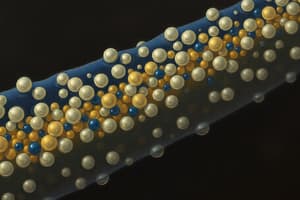Podcast
Questions and Answers
What is the monomer for carbohydrates?
What is the monomer for carbohydrates?
- Amino Acids
- Nucleotide
- Fatty Acids
- Monosaccharides (sugar) (correct)
Which biomolecule forms polypeptides from amino acids?
Which biomolecule forms polypeptides from amino acids?
- Carbohydrates
- Lipids
- Nucleic Acids
- Proteins (correct)
What is the nucleic acid that composes chromosomes?
What is the nucleic acid that composes chromosomes?
- Monosaccharide
- DNA (correct)
- RNA
- Nucleotide
Which term describes the building blocks of polymers?
Which term describes the building blocks of polymers?
How does saturation affect lipid structure and function?
How does saturation affect lipid structure and function?
What is the primary difference between ribonucleotides and deoxyribonucleotides?
What is the primary difference between ribonucleotides and deoxyribonucleotides?
Which of the following statements about DNA base composition is true?
Which of the following statements about DNA base composition is true?
What type of linkage occurs between nucleotides during polymerization?
What type of linkage occurs between nucleotides during polymerization?
What is the primary structural difference between RNA and DNA?
What is the primary structural difference between RNA and DNA?
What is the primary function of ribozymes?
What is the primary function of ribozymes?
What determines the acidic or basic nature of proteins?
What determines the acidic or basic nature of proteins?
What type of bonds are responsible for forming the secondary protein structure?
What type of bonds are responsible for forming the secondary protein structure?
What contributes to the distinctive three-dimensional shape of polypeptides in tertiary protein structure?
What contributes to the distinctive three-dimensional shape of polypeptides in tertiary protein structure?
What happens to proteins when they are denatured?
What happens to proteins when they are denatured?
What is the main function of enzymes as proteins?
What is the main function of enzymes as proteins?
What is the molecular formula for carbohydrates?
What is the molecular formula for carbohydrates?
What do plants store sugars as?
What do plants store sugars as?
What are the components of an amino acid?
What are the components of an amino acid?
What type of R-groups do polar and charged amino acids have?
What type of R-groups do polar and charged amino acids have?
What is the primary role of triglycerides in cells?
What is the primary role of triglycerides in cells?
How does the saturation of lipids affect their physical state?
How does the saturation of lipids affect their physical state?
What is the primary role of phospholipids in cells?
What is the primary role of phospholipids in cells?
What influences the permeability of a phospholipid bilayer?
What influences the permeability of a phospholipid bilayer?
What is the basis for cholesterol and hormones such as estrogen and testosterone?
What is the basis for cholesterol and hormones such as estrogen and testosterone?
Flashcards are hidden until you start studying
Study Notes
Functional Examples of Biomolecules in Cells: Lipids
- Lipids are carbon-containing compounds that are insoluble in water due to a high proportion of nonpolar and C-H bonds, making them hydrophobic.
- They are an integral part of cellular membranes and play various roles in cells, such as storing long-term energy, acting as pigments to respond to sunlight, and forming waterproof coverings.
- There are four major types of lipids: triglycerides, steroids, phospholipids, and waxes, each with distinct properties and functions.
- Triglycerides, composed of glycerol and fatty acid tails, primarily serve as energy storage due to the large number of high-energy bonds in the fatty acid chains.
- The saturation of lipids affects their physical state, with double bonds in lipids making them healthier and more unsaturated lipids being liquid at room temperature.
- Steroids, characterized by a bulky four-ring structure, form the basis for cholesterol and hormones such as estrogen and testosterone.
- The fluidity of lipids is influenced by the saturation and length of the fatty acid tails, with unsaturated lipids being more permeable and saturated lipids being less permeable.
- Phospholipids, which are amphipathic, play a primary role in forming cell membranes and have hydrophilic "head" regions and hydrophobic "tail" regions.
- Phospholipid bilayers exhibit selective permeability, allowing small or nonpolar molecules to move across quickly, while charged or large polar substances cross slowly, if at all.
- The degree of saturation and length of the hydrocarbon tails, as well as the presence of cholesterol, can influence the permeability of a phospholipid bilayer.
- Lab-created membranes like liposomes and planar bilayers are used to study permeability and behavior of phospholipids in water.
- Overall, lipids have a wide array of functions and are essential components of cells, with diverse roles in energy storage, signaling, and membrane structure.
Studying That Suits You
Use AI to generate personalized quizzes and flashcards to suit your learning preferences.




